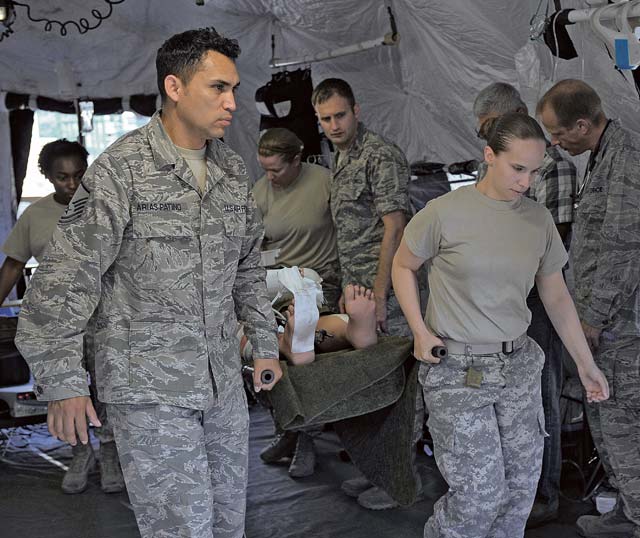
Regardless of the branch a service member belongs to, capable and efficient medical staff are essential to getting injured personnel home safe.
As the military becomes more integrated, the chances of medical teams being composed of members from multiple services learning and working with each other to better improve interoperability increases, and members of the 86th Medical Group tactical critical care evacuation team-enhanced and the 160th Forward Surgical Team got such a chance July 18 on Ramstein.
“I have deployed with augmentees that were Air Force personnel,” said U.S. Army Maj. Gustavo Moreno, 160th FST commander. “They knew what to do because they had been training with the Army.
“Medicine is medicine no matter the uniform you wear,” Moreno continued. “The Air Force has its unique mission that involves aircraft. We have a unique mission that involves going forward with combat units. The goal of today is to share our knowledge and learn new skills from each other.”
The FST is a small mobile surgical unit to be positioned as far forward as possible to deliver surgical capability for injured service members who would be unable to survive a medical evacuation.
The TCCET-E is designed to perform in-flight surgery on patients in critical life-threatening conditions who cannot wait or are not close to an area with an adequate medical facility.
The training focused on the FST mission, which requires the team to be able to set up and be capable of performing medical operations within a 90 minute timeframe. However, 160th FST members did get to see part of the TCCET-E capabilities, particularly, those that allow them to deal with injuries at different elevations and air pressures.
For many of the participants, this was a first look at the capabilities of what their counterparts could do, and for some U.S. Army ROTC cadets here as part of the Nurse Summer Training Program, this was a first seeing multiple services working closely together.
“It’s very interesting to see how they adapt to the environment they are in,” said Cadet Tamara Lazaruk, U.S. Army ROTC from Stephen F. Austin State University. “They can set this up in the middle of a forest, and it’s very interesting to see how they operate with one another. Also, I have never worked in a joint force before my internship, where I work with Air Force captains. It’s nice to see a different side of the military. They are no different than Army personnel.”
Lazaruk and the seven other Army cadets here in the NSTP, who could potentially be assigned to an FST unit one day, were not the only ones to make the realization that all military medical personnel are on the same team, doing the same job.
“Since we know these people and work shoulder-to-shoulder with them in the operating room or the wards we notice that our job is the same thing; we just call it something different,” Moreno said. “Why not train together? We all get something out of it; we become better professionals, and we make a much more integrated force.”


